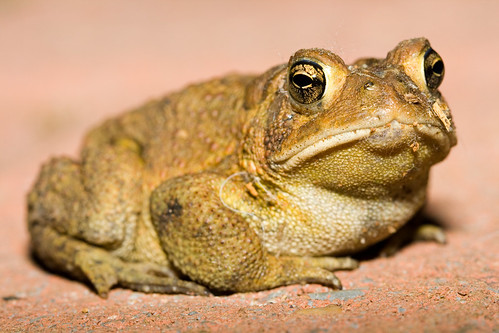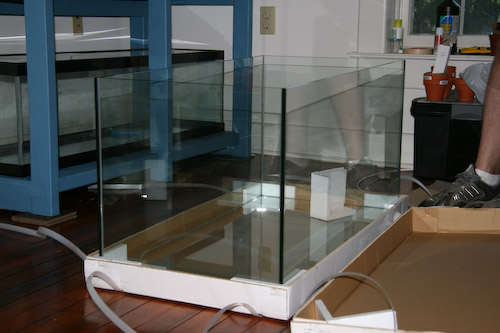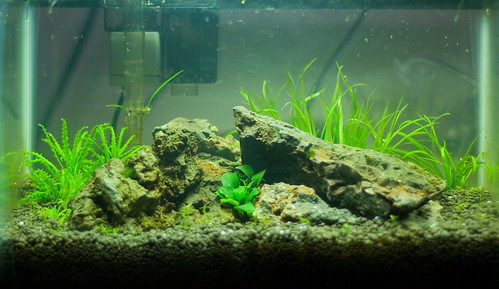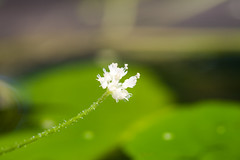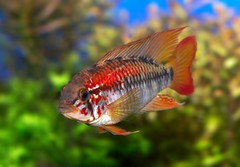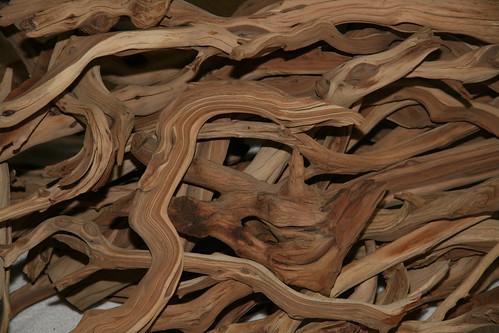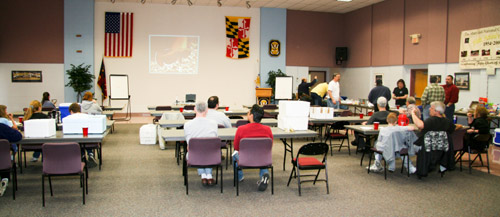
Milling around before the meeting |
The Capital Cichlid Association’s April 2007 meeting featured a well-known dwarf cichlid expert, Ted Judy, from Colorado to speak about west African dwarf cichlids of the Pelvicachromis genus.
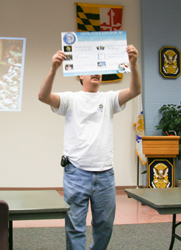 |
| Pat shows off the new poster. |
Before the meeting started, everyone was milling around, engaging in typical fish talk, and admiring the upcoming auction goods. Pat Kelly, CCA‘s president, opened the meeting by showing off a new club poster that is going to be spread around to the local stores to help advertise the clubs’ existence.
Then, Pat introduced Ted Judy, who had prepared an excellent presentation about the Pelvicachromis genus of west African cichlids. Ted opened his presentation with a brief overview of the cichlid family. Pelvicachromis is a very popular group of cichlids that have
 |
| Ted Judy |
been in the hobby for a long time. The Pelvicachromis pulcher was first kept and bred in the 1960s, and gained widespread affection since it is a colorful fish, that is peaceful enough to be kept in a community setting. In general, Pelvicachromis can be easily sexed by looking at the ventral fin. A male will have a pointed ventral fin, with iridescent blue markings, while a female’s fins will be more rounded. All Pelvicachromis species are coastal fish, found only in freshwater streams/rivers within 100 miles of the ocean. Their habitat does not consist of much vegetation, so the substrate is quite silty/muddy. Therefore, the Pelvicachromis often sift the sand, feeding on decaying matter and invertebrates found in the sand. The pH of these streams is usually close to neutral, 7.0.
Based on Ted’s observations in the wild, he has come up with his own unique formula for feeding his Pelvicachromis. Since their diet consists of 70-80% vegetable matter, he tries to replicate this by mixing vegetable and spirulina flakes, with a small portion of protein-based flakes, such as “cichlid flakes” into one container. He then feeds his fish this combined flake mix, ground into small pieces so that it can be easily eaten. To rear fry, or prepare fish for spawning, he will mix in some brine shrimp, daphia, or grindle/white worms. He will also feed krill to bring out more color in a fish.
When seeking breeding pairs, Ted recommends buying a group of 6 fish, and putting them into a smallish 20G tank. Within a month, if a pair has formed, Ted removes all but the weakest other fish. He has found that by leaving one extra Krib in the tank, the pair has a target to “beat” on, which helps to strength the pair’s bond. Setting up the Krib’s breeding space is relatively straight forward; just add a few hollowed-out coconuts, with just enough space for the male to enter. He notes that pH affects the ratio of male and female fry produced. More acidic water produces more females, while alkaline water tends to create more males. Once the fry are free swimming, raise them on powdered flake food and brine shrimp, and make sure to do lots of water changes. Ted does a 20% water change everyday when first raising fry.
Ted then proceeded to discuss many different species and color morphs of Pelvicachromis, providing pictures of each. He did an excellent job giving geographic collection information for each species, as well as, the probability of finding each species domestically depending on political or logistical complications. Each species was accompanied by a slew of information that I recommend you research further on web:
Ted Judy’s profile on Cichlid Room
apistogramma.com
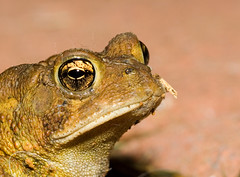 One evening this week, I glanced outside at my raised brick pond, and noticed that the spring foliage and pond had attracted a little toad to our patio. After my dogs gave it a thorough inspection, the toad remaining perfectly still to avoid absolute detection, I thought it would make the perfect photo subject. I grabbed my camera, slapped on the macro lens, got down on my belly, and shot the little guy for about 5-10 minutes. Besides the motion of inhaling and exhaling, he didn’t move a muscle. He didn’t even blink when the flash went off. I hope this guy sticks around for the duration of the summer. I hope you enjoy the pictures!
One evening this week, I glanced outside at my raised brick pond, and noticed that the spring foliage and pond had attracted a little toad to our patio. After my dogs gave it a thorough inspection, the toad remaining perfectly still to avoid absolute detection, I thought it would make the perfect photo subject. I grabbed my camera, slapped on the macro lens, got down on my belly, and shot the little guy for about 5-10 minutes. Besides the motion of inhaling and exhaling, he didn’t move a muscle. He didn’t even blink when the flash went off. I hope this guy sticks around for the duration of the summer. I hope you enjoy the pictures!